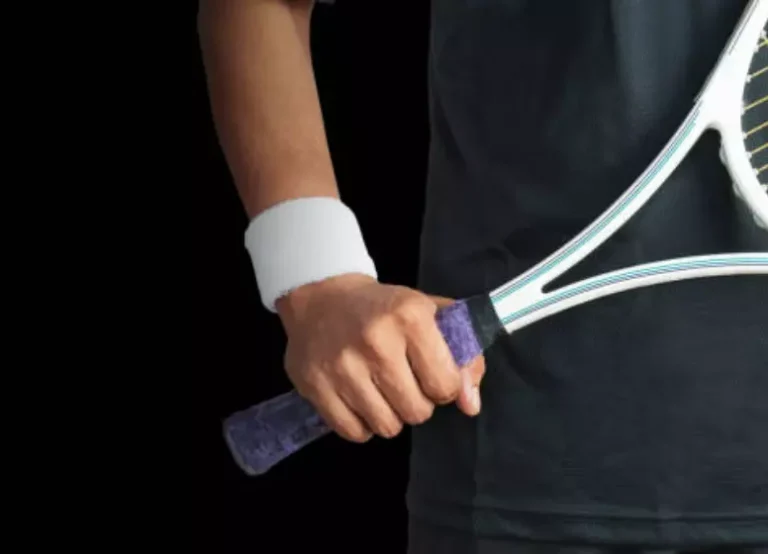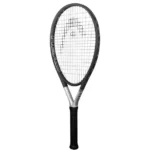Choosing the perfect tennis racket is no easy task, regardless of whether you’re picking up a racquet for the first time or have been playing for a while. Of all the factors to consider, the tennis racquet grip size is one of the most often overlooked.
This article is designed to help you understand the importance of the grip size of a tennis racquet and what the different sizes available are, as well as How to Measure Tennis Racket Grip Size. Let’s get started!
Understanding the Importance of Tennis Racket Grip Size
The grip size of a tennis racket refers to the circumference of the handle. It plays a vital role in your overall performance and comfort while playing. A grip that is too small or too large can negatively impact your control over the racket and increase the risk of injury. Therefore, it is crucial to measure and select the appropriate grip size for your individual needs.
Why does tennis grip size matter?
The grip size of your racket matters a lot if you’re a first-time tennis player. A tennis racquet with the wrong grip size will feel awkward and uncomfortable to play with. Essentially:
- Tennis racquets with too small grips will require you to forcefully grip them to prevent them from twisting or even slipping out. Tennis elbow and other tennis injuries are often caused by this, and it could even cause painful blisters.
- Having a big grip on your tennis racquet will make it tough to grip, making the racquet uncomfortable to play with. In some cases, it can also cause tennis elbow and other injuries since it prevents you from getting enough wrist snaps on your serve.
The grip size of your tennis racquet can be influenced by your grip size, so taking the time to measure can be very important. However, it is ultimately up to you to decide what grip size feels most comfortable to you.
Tennis Racquet Grip Size Explained in 2023

Tennis racquets have grip sizes that are determined by the circumference of their handles, or the distance around their handles. The size of your hand will determine the size of your tennis grip.
There are usually four inches to four 3/4 inches of grip space between most grips. That is equivalent to grip sizes 2, 3, and 4 in the UK and other European countries.
There is often a mark on the butt cap of a tennis racquet indicating the grip size. If not, look for a small label or print on the throat of the racquet telling you what size grip it has. It is very common for a tennis racquet to be marked with both the European and US version of the grip size.
You may enjoy reading The Eastern Forehand Grip in Tennis
Tennis Racquet Grip Size Chart
Below is a table showing European grip sizes and their equivalent sizes in millimeters and inches, so you can convert grip measurements no matter what country you live in:
| European Grip Size | US Grip Size | Size in Millimeters |
|---|---|---|
| 0 | 4 inches | 100-102 mm |
| 1 | 4-1/8 inches | 103-105 mm |
| 2 | 4-1/4 inches | 106-108 mm |
| 3 | 4-3/8 inches | 109-111 mm |
| 4 | 4-1/2 inches | 112-114 mm |
| 5 | 4-5/8 inches | 115-117 mm |
| 6 | 4-3/4 inches | 118-121 mm |
How to Measure Tennis Racquet Grip Size
You’ll want to know How to Measure Tennis Racket Grip Size once you understand what tennis racquet grip size means. You can measure the grip size of a tennis racquet in two ways:
By using your index finger

When you are checking out new tennis racquets in a store and have the opportunity to hold the grip, this method is probably the most common way to measure grip size. You can check the gap between your fingertips and your palm by gripping the racquet handle. In order to achieve the perfect grip size, the gap needs to be just about the size of your index finger.
If possible, try a size up and a size down once you’ve found a close match for your grip size. In this way, you can determine whether that grip is more comfortable for you than another. As a result, you should choose the grip size that feels most comfortable to you based almost entirely on this guide.
By using A Ruler

To determine the size of your tennis grip, measure the size of your hand using a tape measure or ruler if you’re shopping online and won’t be able to hold the grip physically. Open your hand with your fingers fully extended and you will see two large lines running nearly horizontally across your palm if you use a ruler to measure your grip size. The point of your ring finger should be aligned with the bottom lateral crease of your ruler or measuring tape.
Having trouble finding the right size tennis grip?
Our recommendation is to choose a smaller grip size if you have trouble finding the right size. A tennis grip can be increased or decreased much easier than it can be decreased.
Tennis overgrips, which are typically 1/16-inch thick, can be used to increase the size of a tennis grip.
The handle is often comforted by adding an overgrip, which often provides a little extra padding and makes it easier to hold. Many players buy a size down anyway to make it more comfortable to hold. With a heat shrink sleeve added to the grip, the grip size can even increase by 1/8 inch.
Tennis racquets can be very costly and difficult to reduce in size, so it might be cheaper and easier to simply buy a new one.
You may enjoy reading Best Tennis Racquet Brands
Grip Size: Why Does It Matter?

You will experience better comfort and prevent injury with a grip that is appropriately sized.
Using a grip that is too small will cause your hand to twist during a strike, resulting in painful blisters and unnecessary strain on your arm because you are overcompensating. Tennis elbow, for example, can develop as a result of this over time.
Furthermore, when sweating heavily, a small grip can lead to a greater risk of slipping.
Additionally, if your grip is too large, you may have difficulty holding the object, which can result in unnecessary stress on your hands, wrists, and arms.
Furthermore, a large grip is difficult to use when changing grips quickly and snapping your wrist when hitting a forehand, serving, or hitting an overhead since it restricts wrist movement.
Finding the right grip size is key to maintaining a proper range of motion and feeling comfortable.
Spin-maximizing grip size
There is a popular argument among players that they can generate more topspin with smaller grip sizes, which, they claim, provide better control and faster ball release.
The size two grip Rafael Nadal uses makes him feel right and allows him to generate maximum spin. His high RPMs are noteworthy and certainly worth considering as a player, given that he hits with some of the highest RPMs on the ATP tour.
Furthermore, it emphasizes that you should only experiment with grip sizes until you find the best fit, resulting in high performance.
Men’s vs. Women’s Grip Sizes
There is no gender specificity in the grip size of tennis racquets.
Despite the fact that women’s hands are often smaller than men’s, the measurements or sizes are not different.
Grip size average or most common
Most people use a size 3 or 4 3/8 grip. This size is popular with both men and women.
It’s likely that most women will play with a grip size of 1, 2, or 3. Sizes 3, 4, and 5 are typically worn by men, while sizes 3, 4, and 5 are typically worn by women.
Many players fall outside of these ranges, so it’s important to do your research before committing to grip size.
4 3/8 vs. 4 1/2 Grip Sizes
Choosing between a size 3 and a size 4 grip when buying a tennis racquet is common among men.
I recommend choosing 4 3/8 if you’re considering the two because building up a grip is much easier than reducing it, and the difference between the two is only an eighth of an inch.
It may also work for you to add one overgrip for an additional half size or 1/16 inch to a size 4 3/8 grip.
Kids’ Tennis Racquet Grip Sizes

There are typically fewer grip sizes available for kids than for adults. A majority of them fall between 4 and 6 inches, depending on the manufacturer.
Parents should focus instead on the racquet’s length, which corresponds to their child’s height, rather than the grip size. These sizes are outlined in the following chart.
Inches
| Age | Height | Racquet |
|---|---|---|
| 4 or younger | 40 in or less | 19 in |
| 4-5 years | 40-44 in | 21 in |
| 6-8 years | 45-49 in | 23 in |
| 9-10 years | 50-55 in | 25 in |
| 10 or older | 55+ in | 26 in |
Centimeters
| Age | Height | Racquet |
|---|---|---|
| 4 or younger | 102 cm or less | 48.3 cm |
| 4-5 years | 102-113 cm | 53.3 cm |
| 6-8 years | 114-126 cm | 58.4 cm |
| 9-10 years | 127-140 cm | 63.5 cm |
| 10 or older | 140+ cm | 66.0 cm |
A child’s grip size should be determined by the size of the tennis racquet they can comfortably handle.
The grip being a little bit large wouldn’t worry me too much, however. As your child grows into it, they won’t be playing aggressively or for long enough to cause any harm to their hands, wrists, or arms.
You may enjoy reading Best Tennis Rackets Under $100
Sizes of pro player grips
The grip size of some of the world’s top players might be helpful or interesting to you as a reference.
Most of the players listed use grip sizes of 3 or 4 3/8 inches, which is something you might notice right away.
ATP Grip Sizes
| Players | Grip Size |
|---|---|
| Rafael Nadal | 4 1/4 |
| Roger Federer | 4 3/8 |
| Novak Djokovic | 4 3/8 |
| Andy Murray | 4 3/8 |
| Dominic Thiem | 4 1/4 |
| Alexander Zverev | 4 3/8 |
| Stefanos Tsitsipas | 4 3/8 |
| Daniil Medvedev | 4 3/8 |
| Nick Kyrgios | 4 3/8 |
| Grigor Dimitrov | 4 3/8 |
WTA Grip Sizes
| Players | Grip Size |
|---|---|
| Serena Williams | 4 5/8 |
| Venus Williams | 4 5/8 |
| Maria Sharapova | 4 3/8 |
| Caroline Wozniacki | 4 3/8 |
| Sloane Stephens | 4 3/8 |
The grip size remains the same throughout a player’s career, regardless of the racquet they use.
Factors to Consider When Choosing a Tennis Racket Grip Size

When selecting a grip size for your tennis racket, consider the following factors:
Player’s Hand Size
Hand size is a crucial consideration when determining the grip size. Larger hands typically require bigger grip sizes, while smaller hands may benefit from smaller grip sizes.
Playing Style and Grip Technique
Your playing style and grip technique also influence the ideal grip size. For example, players who employ a more aggressive and powerful playstyle might prefer a slightly larger grip size for increased stability and control.
Personal Preference
Ultimately, personal preference plays a significant role in grip size selection. Some players may prefer a tighter grip for better control, while others may opt for a slightly looser grip for more wrist movement and comfort.
you may enjoy reading Different Parts of a Tennis Racket
Common Mistakes to Avoid

To ensure a successful grip size measurement, avoid the following mistakes:
Neglecting the Grip Size Importance
Some players underestimate the significance of grip size, which can negatively impact their gameplay and increase the risk of injury. Always prioritize measuring and selecting the appropriate grip size.
Relying on Guesswork
Guessing or assuming your grip size can lead to an ill-fitting racket handle. It is essential to measure the grip size accurately using the proper tools to maximize your performance on the court.
Ignoring Comfort and Control
Choosing an incorrect grip size can result in discomfort and a lack of control during gameplay. Take the time to find the right grip size that enhances both your comfort and control.
You may enjoy reading Best Women’s Tennis Rackets
Benefits of Using the Correct Grip Size

Using the correct grip size for your tennis racket offers several advantages:
Enhanced Performance and Control
The right grip size provides optimal control over your racket, allowing you to execute shots with precision and confidence. This, in turn, improves your overall performance on the tennis court.
Reduced Risk of Injury
An ill-fitting grip size can strain your hand, wrist, and forearm muscles, increasing the likelihood of developing injuries such as tennis elbow. By using the correct grip size, you can minimize the risk of such injuries.
Improved Comfort during Gameplay
Playing with a grip size that suits your hand size and playing style enhances comfort during extended gameplay sessions. A comfortable grip allows you to focus on your technique and enjoy the game to the fullest.
Frequently Asked Questions
What is the proper way to measure tennis racket grip size?
Racket grip sizing charts or racket grip sizing tools can be used to measure tennis racket grip size. You must measure the circumference of your hand just below the knuckles, without including the thumb, in both methods.
How do I use a racket grip sizing chart?
A racket grip sizing chart should be used by measuring your hand just below your knuckles, excluding your thumb. Match your measurement with the corresponding grip size on the chart.
Can grip size be adjusted on a tennis racket?
Adding or removing grip layers or using an overgrip on a tennis racket can adjust grip size. A racket may not have enough room to adjust the grip size if it does not have enough room.
How does grip size affect my tennis game?
Proper grip size can reduce hand and wrist strain and improve control and power in your tennis shots, thereby improving your game. When your grip is ill-fitting, you may feel uncomfortable and your performance may be hindered.
What if my hand measurement falls between two grip sizes on the chart or tool?
When choosing a grip size based on your hand measurement, choose the smaller one. Grips can be added to rackets easier than they can be removed.
How do I use a racket grip sizing tool?
A racket grip sizing tool can be used by placing the tool on the palm of your hand just below the knuckles. Once the grip size is determined, the tool will indicate it.
What’s Next?
While finding the right grip size can be a bit of a challenge, it pays off to find something that is comfortable and allows you to perform well. Luckily, you will only need to identify the correct grip size once. As soon as you’ve determined what size works for you, you’ll know what to order in the future.
The grip size of a 27-inch tennis racket is more variable than the grip size of a 27-inch mini racquet, so don’t worry too much about that as a parent. It is also likely that you will have to remeasure the grips as your child grows.
We have compiled a list of the top 20+ racquets for 2022, so you can choose the grip size that’s right for you. In the comments below, please feel free to ask any questions you may have.
Additionally, you should know which equipment you need, such as tennis shoes, tennis balls, tennis rackets, tennis sunglasses, and tennis shorts.




Comments are closed.